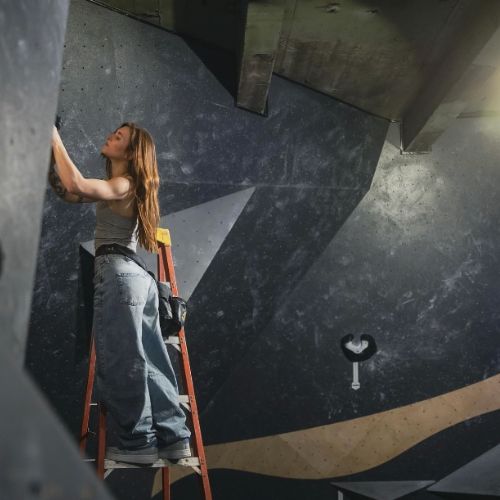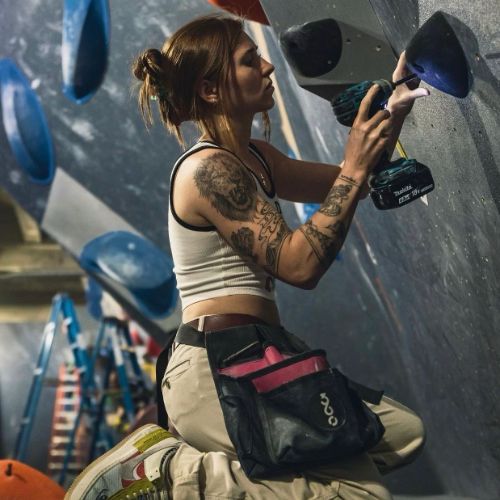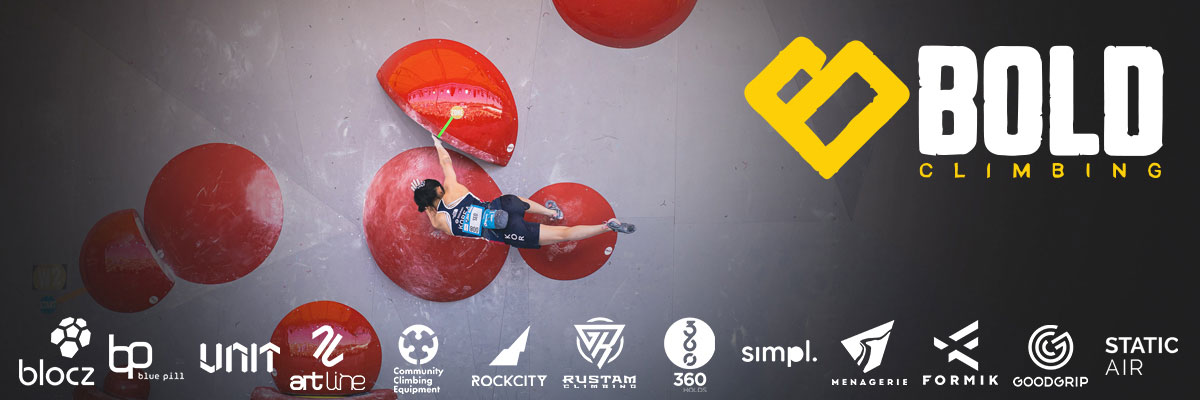
On this episode of The Impact Driver Podcast, host Holly Chen meets with Annabelle Spingler. Annabelle has been climbing and working in climbing gyms since she was 17. She started as a birthday party belayer and coach but has always been intrigued by routesetting. So, when the headsetter accidentally stripped too much of the gym for a competition, she asked if she could set a few boulders to fill in the space, and that’s how her routesetting journey began. Annabelle also loves setting for competitions, having set for two NACS competitions, Jackalope and other events, and she is currently a USAC L3 routesetter.
In their chat today, Annabelle and Holly dissect an age-old concept: aesthetics versus function. To start, Annabelle defines aesthetics a little differently. They then talk about how function in a competition might be hard to nail down just by looking at results on paper; they bounce some ideas around on how to introduce advanced comp movement to a newer audience (Annabelle calls it spoon feeding); and they discuss what aesthetics means in a gym with tens of thousands of dollars to spend on macros and fiberglass versus a gym without those funds. Holly and Annabelle also chat about whether movement is finite or whether routesetters can “discover new movement.” And Annabelle lists some ways to help routesetters focus on aesthetics by giving them “zones.”
Thank you Bold and Approach for your support!
And thank you Devin Dabney for your music!
Timestamps
00:00 – Intro
04:10 – Aesthetics in Routesetting
05:05 – Well-Functioning Climbs
09:13 – Importance of Aesthetics
13:19 – Setting New Moves
17:54 – Setting Aesthetically Without Macros
23:25 – Mixing Holds and Shades When Setting a Route
25:20 – Making Smaller Holds Aesthetically Pleasing
27:11 – “Chaos Bombs”
30:22 – Sacrificing Function for Aesthetics
33:39 – Introducing Comp Movement to Novice Audiences
43:08 – Dealing With Member Pushback
50:45 – Closing
Abridged Transcript
… Annabelle, can you give me your definition of aesthetics? Like, what is aesthetics in route setting?
I guess the obvious basic answer is just how a boulder looks on the wall or how a set of boulders looks on the wall, not necessarily just one boulder. It’s a difficult answer to say what is good versus bad aesthetics because it’s so subjective. But I think at its core for me, the purpose of aesthetics is to elicit a reaction. And that’s what I’ve been more into lately…[The reaction] might be good or bad. Somebody might be like, “I hate that,” but either way, it evokes a reaction, and it’s the same way as if you’re getting food and it looks good. That’s the first thing you see about a boulder is what it looks like. So, if that can draw somebody in, then cool.
What about the opposite side of that? What does it mean when a climb functions well?
So, there are a lot of different parts that go into that, and it can be different, I think, because different boulders can have different purposes. You might have a boulder in a gym that honestly a lot of members are going to love, that’s just a straight-up crimp strength test piece that’s a little bit pass-fail. And I think to a certain extent that’s fine and even good to have in a gym. You shouldn’t have all the boulders be that because if it’s just pass-fail, then that’s not really fun and nobody’s learning. But that could be the purpose of that boulder.
Generally speaking, I think the things that we like to think about when we’re setting boulders and talking about if they function well is whether they’re equitable, for one thing. And I think an important part of that is that equitable is different than everybody doing the boulder the same, which can look different. So, you could have one part of the boulder that’s easier if you’re short and one part that’s easier if you’re tall, or there could be two different betas but they’re both asking a similar level of difficulty, a similar physicality, something like that.
And then can you learn from the boulder? Are you being guided into—if you’re doing a V4, your first skate move, is it something that’s going to be super obvious? What am I supposed to do here? And can I learn it? Can I work on this technique? Repeatably? If you do a boulder, do you want to come back and do it again? Do you want to do it as part of your warmup, or do you want to try to repeat a hard boulder in your session?

…In a competition setting, the function can mean a lot of different things. Do you have anything that drives your philosophy and your opinion on how a boulder functions well in a competition setting?
I think, at its core, function in a comp is separation. So, are you getting separation in the field of people getting tops and zones and then attempts to top and attempts to zone, and all that? But I think that there’s a lot of it that happens that if you’re just looking at results on a page, they can seem really good, and the comp itself was maybe not that cool. Or it could be the opposite, where you might have on paper not the best results and the comp is really cool…So, that to me is important, and I do care that the athletes are having fun and having a good time.
…What does it mean to have a round that functions well in the citizens’ category?
For citizens, I would say something that we try to do a lot that I think is pretty fun is just make them feel cool. If they’re in a comp, give them their first coordo move or their first really mega-burl lock-off move, and let them do it and let them get psyched. I think in a comp in particular, it’s important to have learned boulders because it’s not that fun if you just can’t do a boulder; you’re just going to walk away from it. And that can go into—for one thing, if you set a comp boulder for a citizens’ round and the crux is at the bottom and you can’t even pull off the start, it doesn’t matter if the rest of the boulder is easy because people are just going to walk away. They’re not going to do it. And the same with if you do have some crazy move in the middle, sometimes we will be more inclined to just let them get the top. Then you don’t need to have another really hard move to gatekeep matching the finish hold. If they did the hard thing, let them do it. Especially in [the citizens’ category], it’s most important that people are having fun.
…To you, why do aesthetics matter in setting?
I guess you can split it into two different answers, which is basically why aesthetics would matter as a routesetter and then why it matters for members. Because at the end of the day, I think there’s one hundred percent value in doing things that are going to further your own growth as a routesetter. Some days you need to do what’s going to make you psyched, and then some days you need to do what’s going to make the members psyched. And I think that it’s an easy conclusion to make that, “Members don’t really care, they’re not really looking at it.” But I personally, in my experience, don’t find that to be true at all…
Even if I’m midway through doing a ”chaos bomb,” as my friends like to call what I do sometimes, they’ll walk by and be like, “Woh, what is that?” And it can be different things depending on what you’re doing. It could be, “What is this?” or “That’s really pretty.” Or if you have a really empty wall, just a two-hold boulder or something, it could be like, “Woh, how am I going to climb that?” It could also be different in different portions of the gym. We’ve done things where we have a micro-set on the slab wall, so the entire slab will have nothing but screw-ons, and then right next to it you could have a mega volume cluster, and have some of the gym look quote-unquote “normal,” less crazy.
For one thing, just the basics of getting outside of your comfort zone and using your brain in a different way [is important]. Because some days you’ll come in and want to set this move. Some days you come in and you don’t have a move you want to set or you’re kind of tired, or whatever, and it allows you [to try] different approaches to settings. You could come in and throw volumes at the wall or throw holds at the wall and figure out how they’re going to climb. Or sometimes I’ll come in and pick a bunch of different hold sets that I think are going to look cool together and then figure it out as I go.
…Let’s put this into two camps: Let’s say that we have gyms with really good resources that have a lot of volumes, a lot of fiberglass, and a gym that is maybe a little older or doesn’t have as big of a hold budget. So, let’s talk about aesthetics in a [gym with a large hold budget].
I actually took a photography class last semester to fill my art requirement, and it was really cool because a lot of the concepts that we talked about in setting and aesthetics were lesson plans in this photography class. So, negative space and repetition and symmetry and the rule of thirds are all photography things that I was learning about that are exactly the same things. Which is kind of sick because the concept of aesthetics has crossed over with a lot of different things, not just setting…
Negative space is, I think, one of the most important, where if you’re having something that’s really heavily clustered in one space, then you want a different section of the wall to be empty. Because the point is to draw your eye to different places, and if there’s a lot going on everywhere, you’re going to not really know where to look. In the same way that if I had set a really macro-heavy, really big and loud boulder right here, then I would maybe want to offset it with something that’s a little bit more delicate over on the other side…

…What is your opinion about mixing different shades of coloring [when setting routes]?…
To be honest, I can’t get behind the different shades; that just doesn’t do it for me. But I can definitely get behind mixing hold sets. And it also depends. So, for Method, we kind of have built this aesthetic and a lot of our boulders are kind of clean. And I think that’s something where, amongst the setting crew, we differ a little bit because I like to get a little more chaotic, so to speak. And that’s one of my favorite things to play with in aesthetics is intentional chaos. You can do it in a way that it still looks intentional. It still looks kind of clean because there’s a reason to the chaos…
…Are there any instances where you may sacrifice function for aesthetics? And if there are, what are they?
Obviously, people have different opinions on this…I think if you have a boulder, let’s say a V3, and you have a bunch of footholds on the boulder, and it’s not forced to use every single foothold, but it’s maybe more comfortable if you do, or it climbs better, I think that’s okay if it’s not 100% forced. But I lean pretty heavily in the camp of, “If it doesn’t function, it doesn’t matter if it looks good,” because anybody can do that. Anybody can put [holds] on the wall and make it look pretty. I think what is really impressive is if you can set something that looks whatever your intention is [aesthetically]—if it’s pretty, if it’s symmetrical, if it’s clean, if it’s loud, whatever you want to do there—and it climbs really well. So, another place that I’m willing to have a little bit of leeway in when I’m setting is if I’m having multiple boulders intersect with each other, it’s okay if the boulder isn’t groundbreaking movement for me. It doesn’t have to be some really sick move or really intricate sequence if the purpose of the boulder or the set is something leading more towards aesthetics. But it still has to be comfortable.
…In your opinion, how can a well-functioning boulder introduce comp movement to novice audiences or advanced movement to novice audiences?
…We have over time introduced movements to the members. At first, maybe it was in the higher grades. If you’re going to have a run across, it’s obviously not going to be a V2. One of the important things, if you’re introducing comp movement or coordination or dynamic movement, whatever you want to call it, is if it’s meant for a general member base and not people who are legitimately training to do comps, it should be the most comfortable, accessible version of that move. So, it’s like what I was saying before about making them feel cool. If you’re trying to have a V4 skate move run across and it’s somebody’s first time trying that, for one thing, don’t sandbag it, let them do the boulder. Or maybe if you as a setter think it’s a V4, give it V5 or whatever, make it obvious what it’s meant to be, and make it a comfortable and kind of safe feeling move. So, if it’s their first run across, give them huge feet, and give them a jug. And you don’t need to have a weird, hard finish position. You don’t need to be learning any more in that boulder than just the fact that you’re running. So, that’s what makes the difference between commercial dynamic movement coordination versus comp coordination.

Holly grew up in Taiwan and Hong Kong. Now she lives in Denver where she reports, writes and routesets. Beyond the Climbing Business Journal, her writing has been published by Alpinist Magazine, Climbing Magazine, Gym Climber and Sharp End Publishing. Holly’s motto has always been: “keep it interesting.”
Read our interview with Holly: Storytelling Through Movement









